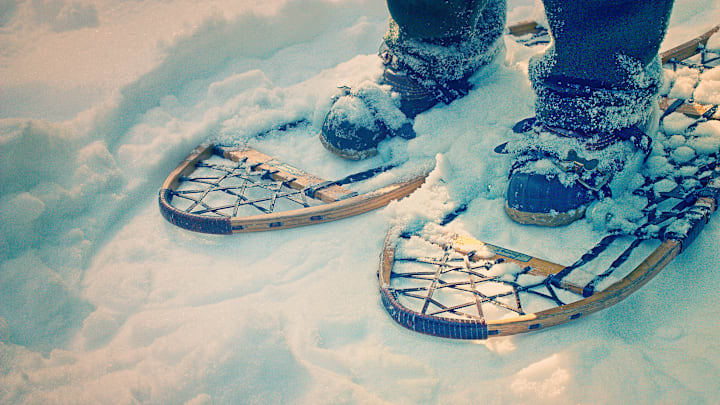Snow is exhausting. It’s beautiful to look at and almost magical to experience, but still, exhausting.
It’s a truth our ancestors had a rather ingenious answer for thousands of years ago, back when staying cozy indoors and ordering delivery wasn’t an option in wintry weather. Instead of trudging through inches of freshly-fallen flakes and having every step sink through the powdery quicksand, they invented the snowshoe, a piece of footwear we’ve spent millennia adapting and outfitting to help us traverse the slush and fluff of the colder months.
The practice of snowshoeing popped up roughly 4000 to 6000 years ago in Central Asia, and from there it spread to Europe and North America. Indigenous people needed a way to get around while trapping, hunting, and traveling over treacherous terrain. Made from wood slats and animal rawhide, early snowshoes resembled oversized tennis rackets, and different models were named after members of the animal kingdom. The snowshoe hare may have been the inspiration for a common Native American showshoe, its shape and size resembling the creature’s large hind feet. Other designs that originated on the continent were named after bear claws and beaver tails [PDF].
Despite its long, rich history—it won wars, became a national pastime in Canada, and even graduated to its own sport in some parts of the world—the basic concept of how the snowshoe works hasn’t changed that much. To understand it, you just need to know a bit about physics.
Imagine you’re trying to make a hole in a sheet of paper. You have a pencil and a penny. The pencil punches right through, while the penny requires more effort. That’s the driving science behind snowshoes. Normal boots have a small surface area, which means the pressure per square inch (or PSI) of every step is greater, or more forceful. Snowshoes are wider and bigger, distributing that pressure across a larger surface area easier—gentler, even—on the snow itself. This is called flotation. The deck of a snowshoe is responsible for distributing your weight, and the larger the deck, the more flotation the shoe provides. Modern snowshoes are even more lightweight than their predecessors, made from inflatable fabrics, plastics, aluminum, and durable polymers that allow them to hold more weight and cross a variety of surfaces.
So, the next time you feel like traipsing through the woods on a serene, snow-covered day—or you have to trudge through icy glop to cross your yard—make sure to bring your snowshoes and take time to appreciate the science behind them.
Read More About Winter:
